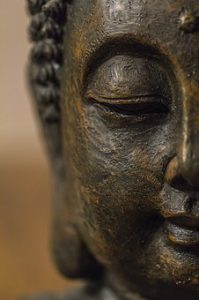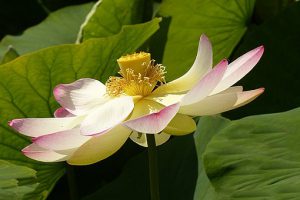Sunday
Dharma TeachingsThe Heart Sutra
An explication of The Sutra of the Heart of Transcendent Knowledge
by Russell Rodgers
 The “Heart Sutra” is chanted by Mahayana practitioners all over the world. You could do it at home to start your meditation. Its full title is “The Sutra of the Heart of Transcendent Knowledge.” “Transcendent knowledge” is also known as “prajnaparamita.” It means, roughly, not “book learning,” but penetrating insight that arises on the spot. The word “sutra” refers to teachings of the Buddha. It is the heart of transcendent knowledge because it is a condensation, the pith, of several longer discourses. So this sutra is a really a starting point for study: it tells you what you need to learn in order to have a proper ground for meditation.
The “Heart Sutra” is chanted by Mahayana practitioners all over the world. You could do it at home to start your meditation. Its full title is “The Sutra of the Heart of Transcendent Knowledge.” “Transcendent knowledge” is also known as “prajnaparamita.” It means, roughly, not “book learning,” but penetrating insight that arises on the spot. The word “sutra” refers to teachings of the Buddha. It is the heart of transcendent knowledge because it is a condensation, the pith, of several longer discourses. So this sutra is a really a starting point for study: it tells you what you need to learn in order to have a proper ground for meditation.
The sutra begins, Thus have I heard….. The Buddha’s teachings were not written down until well after his death, so persons with good oral memory would recite them at gatherings. Needless to say, scholars debate what was actually said, and what words were put into Buddha’s mouth later on. One way of looking at this problem is to consider what has survived as the core teachings of our tradition. This sutra been checked over by countless generations of enlightened lineage masters. So trust in the sutras is really trust in the lineage of those who have put them into practice and found that they work. One’s experience of present day teachers is how one experiences that lineage.
This sutra was expounded at a particular place and time—at Vulture Peak Mountain in India, 2500 years ago. One can visit there today on pilgrimage. In the sutra, Buddha enters into a profound samadhi or deep meditation. A realized disciple, Avalokiteshvara, tunes into that and enters into a samadhi of his own. Shariputra, who has a scientific, questioning mind, asks Avalokiteshvara what is happening, and the sutra unfolds as Avalokiteshvara responds. The Buddha doesn’t utter a word until the very end, when he confirms what has been said. This is one of several styles that the Buddha used to teach.
In the sutra, Shariputra asks: “How should one practice the profound prajnaparamita?” “Prajna”, as we discussed before, means insight. “Paramita” means “other shore”. So in this case we are talking about insight into the ultimate nature of reality, not just the insight into how to cook eggs. On our level, we have to practice it, because we don’t have direct, spontaneous insight yet.
Avalokitesvara answers: one should see the five skandhas to be empty of nature. Form is emptiness; emptiness also is form. Emptiness is no other than form; form is no other than emptiness. Form refers to the first skandha. Skandhas are clusters—literally, “heaps”—of separate mental events that one sloppily conceptualizes as a unitary self, an I.
 Let’s deal first with the form part of this somewhat enigmatic statement. Form is the first skandha. One way of understanding how “form is emptiness” is to consider that our perceptions of form arise in the mind. Forms by their nature cannot physically exist inside of our heads—there isn’t room in there. We have to experience them as mental impressions. Since the mind doesn’t contain actual forms, there is nothing to push aside to make room for a new image of a form. Therefore thoughts, emotions and forms can arise unobstructedly because there is nothing substantial to get in the way. Form is not separate from the emptiness of mind. Mind and form are the same. So form is empty mind and empty mind can become form. Emptiness has a further meaning: one cannot say definitively whether or not forms exist separately from mind. That would be a just another thought, a concept.
Let’s deal first with the form part of this somewhat enigmatic statement. Form is the first skandha. One way of understanding how “form is emptiness” is to consider that our perceptions of form arise in the mind. Forms by their nature cannot physically exist inside of our heads—there isn’t room in there. We have to experience them as mental impressions. Since the mind doesn’t contain actual forms, there is nothing to push aside to make room for a new image of a form. Therefore thoughts, emotions and forms can arise unobstructedly because there is nothing substantial to get in the way. Form is not separate from the emptiness of mind. Mind and form are the same. So form is empty mind and empty mind can become form. Emptiness has a further meaning: one cannot say definitively whether or not forms exist separately from mind. That would be a just another thought, a concept.
Now consider that we have used the term “mind,” and that implies that there is some thing called “mind” that we can conceptualize and give a label to. But no one has ever found a “thing” called mind. One just finds the fleeting perceptions and thoughts that stream through and then disappear. Through what? We call it a self, or a mind, but that is just a label for something that cannot be found. You can check this out for yourself, when the thick underbrush of your discursiveness has been thinned out by shamatha and you have a bit of clarity. “Things” have location, shape, color and so forth. Generations of powerful meditators have looked for mind as a “thing” and not found it.
 Some masters say that what we experience as a self is in fact just a name given to a sense of empty presence that has no content other than what is flowing through, appearing and disappearing. Even the sense of presence, of awareness that knows it is aware, cannot be pinned down as any thing that can be located. It is not enough that one hears and accepts this assertion: the masters say that one needs to look again and again, until one is absolutely certain that nothing called “mind” can be found and that this so-called “mind” is itself empty. The word “mind’ is just a thought. However, it’s a useful thought, and we’ll continue to use it.
Some masters say that what we experience as a self is in fact just a name given to a sense of empty presence that has no content other than what is flowing through, appearing and disappearing. Even the sense of presence, of awareness that knows it is aware, cannot be pinned down as any thing that can be located. It is not enough that one hears and accepts this assertion: the masters say that one needs to look again and again, until one is absolutely certain that nothing called “mind” can be found and that this so-called “mind” is itself empty. The word “mind’ is just a thought. However, it’s a useful thought, and we’ll continue to use it.
The sutra lists the skandhas in sequence: form, feeling, perception, formation and consciousness. “Formation” here refers to the formation of well-developed conceptual patterns of thoughts, labels and emotions. “Consciousness” is the vague sense that someone is there, commenting, perhaps telling you that you are a good or bad meditator. Even though the subtle thought of a commentator comes and goes, because of the speediness of our minds we see those thoughts as a continuous presence of a self. Likewise, each of the other skandhas is a cluster of discontinuous mental events. Conceptual mind sloppily merges all the clusters together under the crude label “I.” As awareness grows, one becomes aware that anything that could be identified as a self is just temporary thoughts and perceptions floating through the space of mind. The idea of an “I” is just another subtle, discontinuous, but persistently recurring thought.
At first the idea of skandhas mistakenly seen as a self seems intellectual, but an experienced meditator can use the teachings on the skandhas to dissolve the sense of duality, of self and other, whenever it arises. This is done by looking directly for an “I” from the point of view of each of the skandhas. For instance, one could look at the sense of an “I” trying to meditate, and ask whether this “I” is the same as the body, the feelings, perceptions, and so on. This kind of meditative questioning can be quite handy, since the sense of a self is at the root discursive thoughts. It is also part of conflicting emotions and our struggle in meditation and in life. Having to take care of a self makes one’s life anxious and meditation tedious.
After dispensing with the self as empty, Avalokitesvara takes on what are translated as “characteristics:” There is no birth and no cessation. There is no impurity and no purity. There is no decrease and no increase. What is being pointed out here is the activity of conceptual mind in making comparisons. Comparisons do not exist by themselves in objective reality. They are a function of conceptual mind. Impurity is a label that we project based on a purely conceptual idea of purity, and purity depends on comparison with impurity. Likewise birth as a concept depends on cessation and decrease depends on increase. These judgments exist in conceptual mind and have no inherent reality outside of the thinking process.
In a single very long sentence, the sutra next declares as empty most of the key concepts in Hinayana Buddhism. (Hinayana refers to the initial, foundation phase of the Buddha’s teaching.)
Therefore, Shariputra, in emptiness, there is no form, no feeling, no perception, no formation, no consciousness; no eye, no ear, no nose, no tongue, no body, no mind; no appearance, no sound, no smell, no taste, no touch, no dharmas; no eye dhatu up to no mind dhatu, no dhatu of dharmas, no mind consciousness dhatu; no ignorance, no end of ignorance up to no old age and death, no end of old age and death; no suffering, no origin of suffering, no cessation of suffering, no path, no wisdom, no attainment, and no non-attainment.
First, Avalokiteshvara reviews the skandhas: form, feeling, perception, formation and consciousness. The psychology of perception comes next, starting with the physical sense organs: eyes, ears and so on. Then he proceeds to the sense consciousnesses associated with the sense organs, and finally to the objects of perception. The objects, sense organs and consciousnesses as groupings are all called dhatus, which could be translated as “elements.”All the elements involved in perception are temporary mental events that make an appearance and then dissolve. They arise in the mind stream in dependence on other temporary events.
 The Sutra mentions “no eye, no ear, no nose….” and so on. Each of these is part of a dependent pattern. The act of seeing an object depends on an object, an eye being present, the direction of the eye, the eye consciousness, the parents of the person who is seeing the object, the food that person ate to keep his body alive and so on. What we have is not a single thing, but a constantly changing stream of events that we take a freeze-frame snapshot of conceptually. If the snapshot matches a pre- existing conceptual category, then we give it a name and think that we have seen a “thing.” Naming something gives it a sense of stability, because even though the appearances change, the name stays the same.
The Sutra mentions “no eye, no ear, no nose….” and so on. Each of these is part of a dependent pattern. The act of seeing an object depends on an object, an eye being present, the direction of the eye, the eye consciousness, the parents of the person who is seeing the object, the food that person ate to keep his body alive and so on. What we have is not a single thing, but a constantly changing stream of events that we take a freeze-frame snapshot of conceptually. If the snapshot matches a pre- existing conceptual category, then we give it a name and think that we have seen a “thing.” Naming something gives it a sense of stability, because even though the appearances change, the name stays the same.
None of the elements in these patterns can stand by themselves as independent entities. The technical term for this is “dependent origination.” They are “dependent” because their temporary appearances depend on a host of other conditions. If they truly existed as provable externalities, they would exist on their own. We have to use the term “appearance” rather than “existence,” because “existence” implies entities that are not just transitory points in a sequence of change. It implies entities that continue to exist outside of our mind stream after we have ceased to notice them.
One might take the position that the self doesn’t exist, but there is a real world of material objects out there, and the sense organs and so forth are also real. We might find such an interpretation comforting and grounding, and some interpretations of Hinayana Buddhism encourage such an understanding. On could, for instance, interpret meditation as an attempt to ground oneself in the real world exclusive of our discursiveness about it. Our modern day science based-culture also has similar ideas about an objective reality.
“Dependent origination” is a difficult concept to understand and even more difficult to incorporate into a stable, ongoing moment-to-moment experience of emptiness. It usually takes a lot of contemplation and many exposures to the logic. The logic undercuts our habitual ways of thinking, so that the experience can open up. If one looks where the concept is pointing to, it later becomes easier to actually see things as mere appearance.
 The next topic in that extended sentence refers to the twelve nidanas, sometimes known as the twelve links. These describe the mechanism of karma: there is no ignorance, no end of ignorance up to no old age and death, no end of old age and death… Briefly, the production of karma starts with a flicker of ignoring of the basic nature of mind. Due to habitual conditioning, the idea of a self that is separate from the other events arises in our mind stream as a substitute for that nature. Then this self responds to these seemingly external events according to further habitual conditioning from previous karma. There arises like, dislike, and indifference to how perceived external events relate to the newly created self. Then there follows a sequence of events where we become more and more involved with our projections, and finally we decide to do something about it. We launch an action towards the “external” object, and this action creates ripples of reaction. This is the stage in the sequence that creates future karma. What follows is birth: the creation of a new situation, or even a new person. This new situation has its own momentum based on the actions that created it, and it evolves into maturation, old age and final death of that person or situation.
The next topic in that extended sentence refers to the twelve nidanas, sometimes known as the twelve links. These describe the mechanism of karma: there is no ignorance, no end of ignorance up to no old age and death, no end of old age and death… Briefly, the production of karma starts with a flicker of ignoring of the basic nature of mind. Due to habitual conditioning, the idea of a self that is separate from the other events arises in our mind stream as a substitute for that nature. Then this self responds to these seemingly external events according to further habitual conditioning from previous karma. There arises like, dislike, and indifference to how perceived external events relate to the newly created self. Then there follows a sequence of events where we become more and more involved with our projections, and finally we decide to do something about it. We launch an action towards the “external” object, and this action creates ripples of reaction. This is the stage in the sequence that creates future karma. What follows is birth: the creation of a new situation, or even a new person. This new situation has its own momentum based on the actions that created it, and it evolves into maturation, old age and final death of that person or situation.
Each cycle further imprints a habitual karmic pattern that comes into play at the beginning of the next cycle. This cycle could take place over the span of a single emotional upheaval, or several lifetimes. From an unenlightened point view, there is no end to old age and death because we are caught in seemingly continuous cycles of karma. From an enlightened point of view, nothing has happened to the empty mind stream: it has just assembled itself into different configurations of appearances that we label as separate life experiences.
Finally, the long sentence concludes with no suffering, no origin of suffering, no cessation of suffering, no path, no wisdom, no attainment and no non-attainment. This final statement declares the Four Noble Truths to be empty as well. Briefly, the Noble Truths, the quintessential teachings of the Hinayana, state that existence is marked by suffering and dissatisfaction, that this suffering is due to positing a self that is separate from the rest of reality, that there are moments of relief and that this relief can be made continuous by means of the Buddhist path. One could take these statements as doctrine, an item of belief guaranteed by the Buddha, much as the Bible is taken as the word of God guaranteed by the prophets. Such beliefs invite intense attachment, and legend says that many of the advanced Hinayana practitioners (called arhats) in attendance at Vulture Peak Mountain had heart attacks. Regardless of their relevancy, the Four Noble Truths are ultimately concepts and like other concepts they dissolve into emptiness in the context of present awareness.
We shouldn’t look down at the arhats: their meditation was so profound that they were able to completely eliminate disturbing emotions. Their clarity and stability was far beyond what most spare-time meditators like us could hope to attain. What Avalokiteshvara is saying is that the arhats still had some beliefs in Buddha’s teachings that were just concepts. These beliefs were useful guidelines at first, but perhaps, for the arhats, had now become obstacles to further insight.
With the Four Noble Truths, Avalokiteshvara has finished emptying out the foundation doctrines of Buddhism in a single long sentence. The rest of the chant is fairly straightforward and easy to understand. Avalokiteshvara cites the results of realizing emptiness: no obscuration and no fear because there is no self to protect. One transcends falsity and attains true complete enlightenment.
Avalokiteshvara then praises the virtues of the mantra of prajnaparamita: OM GATE GATE PARAGATE PARASAMGATE BODHI SVAHA. Translated, this means, roughly, “Hey, gone, gone, gone beyond, completely gone beyond, awake, so be it.” What is being indicated here is that the realization of emptiness takes one into a level completely beyond conventional versions of reality. Not only does one find release from suffering, but ultimately, one obtains the powers of a buddha to help others.
Finally, Buddha utters his first statement in this sutra: “Good, good, O son of noble family; thus it is, O son of noble family, thus it is. One should practice the profound prajnaparamita just as you have taught and all the tathagatas (enlightened ones) will rejoice.” The sutra closes with everyone present, including gods, humans, asuras (demigods who jealously aspire to be gods), and gandharvas (celestial musicians) rejoicing. So be it.
If you are interested in further reading about emptiness, you could try Khenpo Tsultrim Gyamtso’s Progressive Stages of Meditation on Emptiness, published by Zhyi-sil Cho-kyi Gha-tsal, 2001. Another excellent source is Andy Karr’s Contemplating Reality, published by Shambhala, 2007.
 Russell Rodgers has been wondering about this kind of topic for the 39 years that he has been practicing. He resides in the Kootenay mountains of British Columbia, in the town of Nelson, and has graciously agreed to allow publication of his beautiful essays on the Shambhala chants here in the Times.
Russell Rodgers has been wondering about this kind of topic for the 39 years that he has been practicing. He resides in the Kootenay mountains of British Columbia, in the town of Nelson, and has graciously agreed to allow publication of his beautiful essays on the Shambhala chants here in the Times.






Nov 15, 2016
Reply
Thank you so much Russell Rodgers for the Heart Sutra explication (have not yet thouroughly studied it) and all the other explication of Shambhala chants that you have published so far – a real treasure. This work could be the basis of a new Shambhala online course on our chants. In my CV, I have always missed that chants were not taught much. With much appreciation, Irene